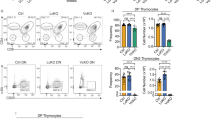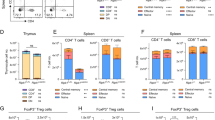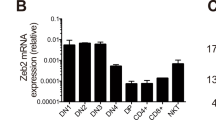Abstract
In contrast to other cell cycle inhibitors, the tumor suppressor p16Ink4a is not detectable or expressed at very low levels in embryonic and adult mouse tissues, and therefore it has often been considered as a specialized checkpoint protein that does not participate in the control of normal cell cycle progression. However, Ink4a−/− mice possess increased thymus size and cellularity, thus suggesting the involvement of p16Ink4a in the control of thymocyte proliferation. In this study, we found increased numbers of CD8 and CD4 T lymphocytes in thymus and spleen from Ink4a−/− mice. Unexpectedly, this was not related to an increase in T-cell division rates, which were similar in lymphoid organs of Ink4a−/− and wild-type mice. In contrast, T-cell apoptosis rates were significantly decreased in thymus and spleen from Ink4a−/− mice. Moreover, whereas p16Ink4a-deficient and wild-type T cells were equally sensitive to Fas or TCR-mediated apoptosis, the former were clearly more resistant to apoptosis induced by oxidative stress or gamma irradiation. Our results indicate that p16Ink4a function is associated with T-cell apoptosis, and subsequently contributes to the control of T-cell population size in lymphoid organs.
This is a preview of subscription content, access via your institution
Access options
Subscribe to this journal
Receive 50 print issues and online access
$259.00 per year
only $5.18 per issue
Buy this article
- Purchase on Springer Link
- Instant access to full article PDF
Prices may be subject to local taxes which are calculated during checkout



Similar content being viewed by others
References
Al-Mohanna MA, Manogaran PS, Al-Mukhalafi Z, Al-Hussein KA, Aboussekhra A . (2004). Oncogene 23: 201–212.
Amstad PA, Liu H, Ichimiya M, Berezesky IK, Trump BF, Buhimschi IA et al. (2001). Redox Rep 6: 351–362.
Ashwell JD, Lu FW, Vacchio MS . (2000). Annu Rev Immunol 18: 309–345.
Azenabor AA, Hoffman-Goetz L . (1999). J Appl Physiol 86: 1823–1827.
Cayota A, Vuillier F, Gonzalez G, Dighiero G . (1996). Blood 87: 4746–4753.
Cemerski S, van Meerwijk JP, Romagnoli P . (2003). Eur J Immunol 33: 2178–2185.
Chazal M, Marionnet C, Michel L, Mollier K, Dazard JE, Della Valle V et al. (2002). Oncogene 21: 2652–2661.
Chen JH, Stoeber K, Kingsbury S, Ozanne SE, Williams GH, Hales CN . (2004). J Biol Chem 279: 49439–49446.
Cope AP . (2002). Arthritis Res 4(Suppl 3): S197–S211.
de Magalhaes JP, Chainiaux F, Remacle J, Toussaint O . (2002). FEBS Lett 523: 157–162.
Fero ML, Rivkin M, Tasch M, Porter P, Carow CE, Firpo E et al. (1996). Cell 85: 733–744.
Franklin DS, Godfrey VL, Lee H, Kovalev GI, Schoonhoven R, Chen-Kiang S et al. (1998). Genes Dev 12: 2899–2911.
Hingorani R, Bi B, Dao T, Bae Y, Matsuzawa A, Crispe IN . (2000). J Immunol 164: 4032–4036.
Holler N, Tardivel A, Kovacsovics-Bankowski M, Hertig S, Gaide O, Martinon F et al. (2003). Mol Cell Biol 23: 1428–1440.
Kim HJ, Nel AE . (2005). J Immunol 175: 2948–2959.
Lagresle C, Gardie B, Eyquem S, Fasseu M, Vieville JC, Pla M et al. (2002). J Immunol 168: 2325–2331.
Lowe SW, Sherr CJ . (2003). Curr Opin Genet Dev 13: 77–83.
Malumbres M, Perez de Castro I, Santos J, Melendez B, Mangues R, Serrano M et al. (1997). Oncogene 14: 1361–1370.
Marrack P, Kappler J . (2004). Annu Rev Immunol 22: 765–787.
Migliaccio M, Raj K, Menzel O, Rufer N . (2005). J Immunol 174: 3335–3343.
Quadrilatero J, Hoffman-Goetz L . (2004). Biochem Biophys Res Commun 319: 894–901.
Remans PH, Gringhuis SI, van Laar JM, Sanders ME, Papendrecht-van der Voort EA, Zwartkruis FJ et al. (2004). J Immunol 173: 920–931.
Rodriguez-Mora OG, Howe CJ, Lahair MM, McCubrey JA, Franklin RA . (2005). Free Radic Biol Med 38: 1653–1661.
Roussel MF . (1999). Oncogene 18: 5311–5317.
Sachs Z, Sharpless NE, DePinho RA, Rosenberg N . (2004). J Virol 78: 3304–3311.
Serrano M, Blasco MA . (2001). Curr Opin Cell Biol 13: 748–753.
Sharpless NE, Bardeesy N, Lee KH, Carrasco D, Castrillon DH, Aguirre AJ et al. (2001). Nature 413: 86–91.
Voorhoeve PM, Agami R . (2003). Cancer Cell 4: 311–319.
Zindy F, Quelle DE, Roussel MF, Sherr CJ . (1997). Oncogene 15: 203–211.
Acknowledgements
We thank Dr Tschopp for providing us with FasL-Fc fusion protein. MM and, NR are supported by the National Center of Competence in Research (NCCR) Molecular Oncology, a research instrument of the Swiss National Science Foundation. TB was partially supported by a grant from Oncosuisse.
Author information
Authors and Affiliations
Corresponding author
Rights and permissions
About this article
Cite this article
Bianchi, T., Rufer, N., MacDonald, H. et al. The tumor suppressor p16Ink4a regulates T lymphocyte survival. Oncogene 25, 4110–4115 (2006). https://doi.org/10.1038/sj.onc.1209437
Received:
Revised:
Accepted:
Published:
Issue Date:
DOI: https://doi.org/10.1038/sj.onc.1209437



